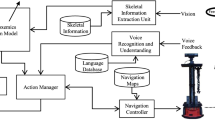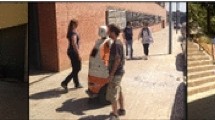Abstract
Each person has their personal area which they do not want to share with others during social interactions. The size of this area usually depends on various factors such as their culture, personal traits, and acquaintanceship. The same applies to the case of human–robot interaction, especially when the robot is required to exhibit a certain level of social competence. Here, we propose a new robot navigation strategy to socially interact with people reflecting upon the social relationship between the robot and each person. To this end, we need a clear definition of interaction areas: (1) quality interaction area where people can be engaged in high-quality interactions with robots, and (2) private area not to be interfered with by the robot speech or action. A technical challenge in enhancing social human–robot interactions is how to enable robots to delineate the boundary of the two areas of each person. Specifically, the social force model (SFM) is designed by a fuzzy inference system, where the membership functions are optimized to give the robot the ability to navigate autonomously in the quality interaction area using a reinforcement learning algorithm. Finally, the proposed model was verified through simulations and experiments with a real robot that can generate a suitable SFM of each person, allowing the robot to maintain the quality of interaction with each person while keeping their private personal distance.

















Similar content being viewed by others
References
Butler JT, Agah A (2001) Psychological effects of behavior patterns of a mobile personal robot. Auton Robot 10(2):185–202
Edward H (1969) The hidden dimension: man’s use of space in public and in private. The Bodley Head Ltd, London
Pacchierotti E, Christensen HI, J P (2006) Embodied social interaction for service robots in hallway environments. Springer, Berlin
Gockley R, Forlizzi J, Simmons R (2007) Natural person-following behavior for social robots. In: 2007 2nd ACM/IEEE international conference on human–robot interaction (HRI), pp 17–24
Hansen ST, Svenstrup M, Andersen HJ, Bak T (2009) Adaptive human aware navigation based on motion pattern analysis. In: RO-MAN 2009—the 18th IEEE international symposium on robot and human interactive communication, Toyama, Japan, pp 927–932
Jaillet L, Cortes J, Simeon T (2008) Transition-based rrt for path planning in continuous cost spaces. In: 2008 IEEE/RSJ international conference on intelligent robots and systems, pp 2145–2150
Kessler J, Schroeter C, Gross HM (2011) Approaching a person in a socially acceptable manner using a fast marching planner. Springer, Berlin
Kim Y, Mutlu B (2014) How social distance shapes human–robot interaction. Int J Hum Comput Stud 72(12):783–795
Kirby R, Simmons R, Forlizzi J (2009) Companion: a constraint-optimizing method for person-acceptable navigation. In: The proceedings of the IEEE international symposium on robot and human interactive communication
Lam CP, Chou CT, Chiang KH, Fu LC (2011) Human-centered robot navigation; towards a harmoniously human; robot coexisting environment. IEEE Trans Robot 27(1):99–112
Lindner F (2015) A conceptual model of personal space for human-aware robot activity placement. In: 2015 IEEE/RSJ international conference on intelligent robots and systems (IROS), Hamburg, pp 5770–5775
Lu DV, Smart WD (2013) Towards more efficient navigation for robots and humans. In: 2013 IEEE/RSJ international conference on intelligent robots and systems, pp 1707–1713
Luber M, Spinello L, Silva J, Arras KO (2012) Socially-aware robot navigation: a learning approach. In: 2012 IEEE/RSJ international conference on intelligent robots and systems (IROS), pp 902–907
Mahadevan S (1996) Average reward reinforcement learning: foundations, algorithms, and empirical results. Mach Learn 22(1):159–195
Mead R (2012) Space, speech, and gesture in human-robot interaction. In: Proceedings of the 14th ACM international conference on multimodal interaction, New York, USA, pp 333–336
Walters ML, Dautenhahn K, RB (2009) An empirical framework for human-robot proxemics. In: Proceedings of new frontiers in human–robot interaction symposium at the AISB09 convention, pp 144–149
Nakauchi Y, Simmons R (2000) A social robot that stands in line. In: Proceedings of 2000 IEEE/RSJ international conference on intelligent robots and systems (IROS 2000), vol 1, Takamatsu, Japan, pp 357–364
Newell PB (1998) A cross-cultural comparison of privacy definitions and functions: a systems approach. J Environ Psychol 18(4):357–371
Pandey AK, Alami R (2010) A framework towards a socially aware mobile robot motion in human-centered dynamic environment. In: 2010 IEEE/RSJ international conference on intelligent robots and systems, Taipei, pp 5855–5860
Papadakis P, Rives P, Spalanzani A (2014) Adaptive spacing in human-robot interactions. In: 2014 IEEE/RSJ international conference on intelligent robots and systems, Chicago, USA, pp 2627–2632
Patompak P, Jeong S, Chong NY, Nilkhamhang I (2016) Mobile robot navigation for human–robot social interaction. In: 2016 16th International conference on control. automation and systems (ICCAS), Gyeongju, Korea, pp 1298–1303
Patompak P, Jeong S, Chong NY, Nilkhamhang I (2017) Learning social relations for culture aware interaction. In: 14th Ubiquitous robots and ambient intelligence (URAI), Jeju, Korea, pp 1298–1303
Rios-Martinez J (2013) Socially-aware robot navigation: combining risk assessment and social conventions. Dissertation INRIA Sophia-Antipolis, France
Rueben M, Smart WD (2016) Privacy in human–robot interaction survey and future work. In: We robot 2016: the fifth annual conference on legal and policy issues relating to robotics, University of Miami School of Law
Sisbot EA, Marin-Urias LF, Alami R, Simeon T (2007) A human aware mobile robot motion planner. IEEE Trans Robot 23(5):874–883
Svenstrup M, Bak T, Andersen HJ (2010) Trajectory planning for robots in dynamic human environments. In: 2010 IEEE/RSJ international conference on intelligent robots and systems, Taipei, pp 4293–4298
Takayama L, Pantofaru C (2009) Influences on proxemic behaviors in human–robot interaction. In: International conference on IEEE/RSJ intelligent robots and systems, IROS 2009, pp 5495–5502
Tomari R, Kobayashi Y, Kuno Y (2012) Empirical framework for autonomous wheelchair systems in human-shared environments. In: 2012 IEEE international conference on mechatronics and automation, Chengdu, pp 493–498
Tora E, Cuijpers RH, Juolia JF, Van Der Pol D (2012) Modelling and testing proxemic behavior for humanoid robots. Int J Humanoid Robot 09(04):1250,028
Tutsoy O, Brown M (2016) Reinforcement learning analysis for a minimum time balance problem. Trans Inst Meas Control 38(10):1186–1200
Westin A (1970) Privacy and freedom. Bodley Head, London
Zeeger SK, Readdick CA, Hansen-Gandy S (1994) Daycare children’s establishment of territory to experience privacy. Child Environ 11:265–271
Acknowledgements
This work was supported by the EU-Japan coordinated R&D project on “Culture Aware Robots and Environmental Sensor Systems for Elderly Support” commissioned by the Ministry of Internal Affairs and Communications of Japan and EC Horizon 2020.
Author information
Authors and Affiliations
Corresponding author
Ethics declarations
Conflict of interest
The authors declare that they have no conflict of interest.
Ethics
This work was conducted in accordance with the JAIST ethical guidances for research.
Additional information
Publisher's Note
Springer Nature remains neutral with regard to jurisdictional claims in published maps and institutional affiliations.
Rights and permissions
About this article
Cite this article
Patompak, P., Jeong, S., Nilkhamhang, I. et al. Learning Proxemics for Personalized Human–Robot Social Interaction. Int J of Soc Robotics 12, 267–280 (2020). https://doi.org/10.1007/s12369-019-00560-9
Accepted:
Published:
Issue Date:
DOI: https://doi.org/10.1007/s12369-019-00560-9




